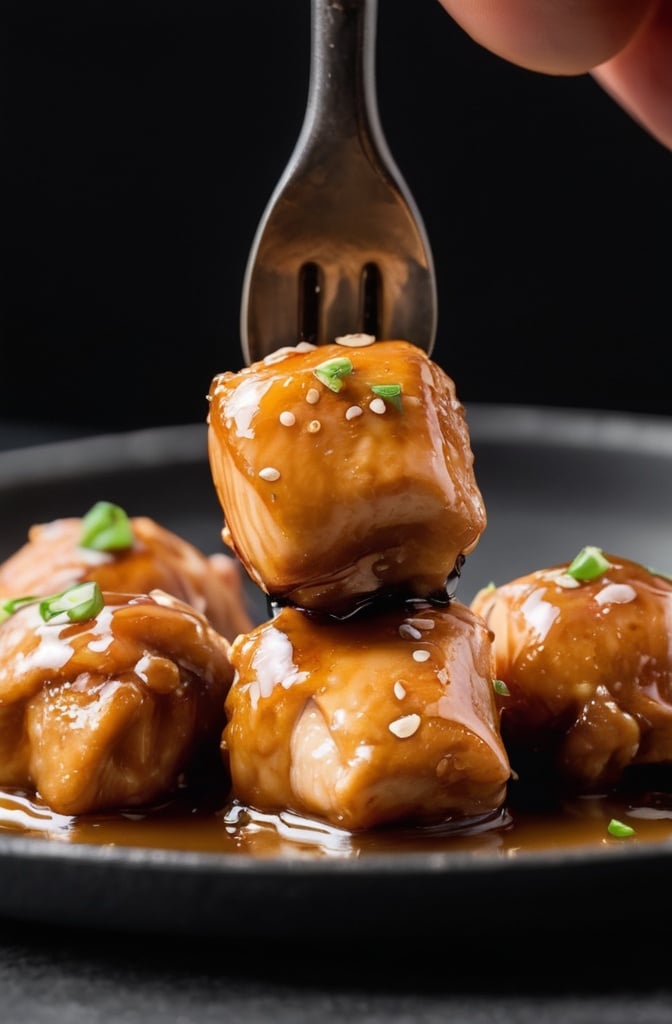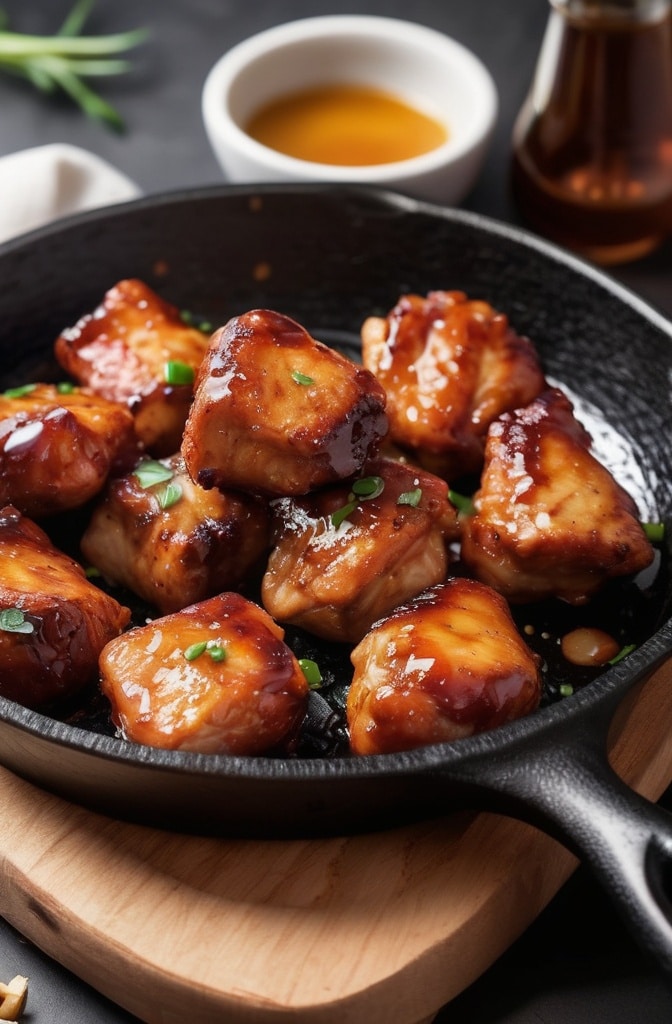The first time I encountered the transformative power of honey garlic chicken bites was on a rain-soaked evening in Taipei’s night markets. Huddled under a makeshift tarp, I watched as the vendor’s skilled hands tossed glistening chunks of chicken in a wok, the aromas of caramelizing honey and toasted garlic cutting through the humid air. One bite that perfect balance of sweet, savory, and umami and I was hooked. I’ve spent years since chasing that perfect flavor combination.
Ever wondered how such a simple combination of ingredients can create such an addictive flavor profile that appeals to virtually everyone? Honey garlic chicken bites represent that rare culinary sweet spot where accessibility meets sophistication. This dish showcases the magic that happens when humble ingredients chicken, honey, garlic undergo the alchemical process of caramelization. The resulting nuggets of flavor deliver a textural contrast that keeps your fork coming back: a crispy exterior giving way to juicy, tender meat, all enveloped in a sticky glaze that manages to be simultaneously sweet, savory, pungent, and complex. Thats the beauty of a dish that transcends its simple components.
Ingredients & Substitutions
For the Chicken:
- 1.5 pounds boneless, skinless chicken thighs, cut into 1-inch cubes
- 2 tablespoons cornstarch (or potato starch)
- 1 teaspoon baking powder (aluminum-free preferred)
- 1 teaspoon kosher salt
- ½ teaspoon white pepper
- 2 tablespoons neutral oil (such as avocado or grapeseed)
For the Honey Garlic Sauce:
- 8 cloves garlic, minced (about 3 tablespoons)
- 2 tablespoons fresh ginger, grated
- ⅓ cup honey (local wildflower honey if possible)
- 3 tablespoons soy sauce (or tamari for gluten-free)
- 2 tablespoons rice vinegar
- 1 tablespoon toasted sesame oil
- 1 teaspoon crushed red pepper flakes (optional)
- 1 tablespoon cornstarch mixed with 2 tablespoons water (slurry)
For Garnish:
- 2 green onions, thinly sliced on a bias
- 1 tablespoon toasted sesame seeds
- Fresh cilantro leaves (optional)
Let’s talk chicken selection, because it matters more than you might think. While breast meat might seem leaner and healthier, thigh meat is significantly more forgiving and resistant to overcooking. Those extra few grams of fat create a moisture insurance policy that keeps your chicken juicy even when subjected to high-heat cooking methods. If breast meat is you’re only option, reduce cooking time slightly and watch it like a hawk overcooked breast meat becomes disappointingly stringy and dry.
For those navigating dietary restrictions, several thoughtful substitutions can preserve the essence of this dish. Vegetarians can swap in extra-firm tofu (pressed for 30 minutes to remove excess moisture) or tempeh, while those avoiding soy might consider chunks of cauliflower florets (though cooking time will need adjustment). The cornstarch can be substituted with arrowroot powder for those avoiding grains, though the resulting texture will be slightly less crisp.
Honey selection deserves special attention. Commercial filtered honey often lacks the nuanced floral notes that make this dish sing. Opt for raw, local honey whenever possible—wildflower varieties offer complexity that plays beautifully against the pungent garlic. For vegan preparations, pure maple syrup (not pancake syrup) makes an excellent substitution, adding a slightly different but equally delicious dimension to the sauce.
Step-by-Step Instructions

Preparing the Chicken
- Begin by patting the chicken pieces thoroughly dry using paper towels. Excess moisture is the enemy of crispness, and removing it allows for better cornstarch adhesion and more efficient browning. Many cooks skip this crucial step, resulting in chicken that steams rather than sears.
- In a large bowl, combine the cornstarch, baking powder, kosher salt, and white pepper. The baking powder might seem like an unusual addition, but it creates microscopic bubbles during cooking that result in a lighter, crispier exterior. Trust me on this seemingly strange addition the science is solid.
- Add the chicken pieces to the cornstarch mixture and toss thoroughly to coat. Each piece should have a thin, even layer of the mixture. Let the coated chicken rest for 10 minutes, allowing the starch to hydrate slightly which helps create that coveted textural contrast between exterior and interior.
Cooking the Chicken
- Heat a large, heavy-bottomed skillet (cast iron is ideal) or wok over medium-high heat until it’s properly hot. A drop of water should dance and evaporate immediately on contact. Many home cooks make the cardinal error of starting with a pan that’s not hot enough, resulting in chicken that sticks and steams rather than sears.
- Add the neutral oil, swirling to coat the cooking surface, then carefully arrange the coated chicken pieces in a single layer, making sure not to crowd the pan. Depending on your pan size, you may need to work in batches—overcrowding is a common mistake that leads to soggy rather than crispy chicken. Leave the pieces untouched for 2-3 minutes until they develop a golden-brown crust.
- Using tongs or a spatula, flip each piece and continue cooking until all sides are golden and the internal temperature reaches 165°F (74°C), approximately 5-7 minutes total. If cooking in batches, transfer the cooked chicken to a wire rack set over a baking sheet rather than a plate—this prevents the bottom from steaming and losing its crispness.
Making the Sauce
- Reduce the heat to medium and, in the same pan, add the minced garlic and grated ginger. The residual fat and fond (those browned bits stuck to the pan) are flavor gold that will become part of your sauce. Sauté for 30-45 seconds until fragrant but not browned—garlic becomes bitter when overcooked, a mistake that can ruin the entire dish.
- Add the honey, soy sauce, rice vinegar, sesame oil, and red pepper flakes (if using). The mixture will bubble vigorously as the liquids hit the hot pan, releasing an intoxicating aroma that will make your neighbors jealous. Allow the sauce to simmer for 1-2 minutes, letting the flavors meld and the mixture reduce slightly.
- Give your cornstarch slurry a quick stir (it settles quickly) and drizzle it into the simmering sauce while whisking constantly. Continue to cook, stirring frequently, until the sauce thickens to a glossy consistency that coats the back of a spoon, about 1-2 minutes. For a thinner sauce, use less slurry; for something more substantial, add a bit more.
Finishing the Dish
- Return the crispy chicken to the pan with the sauce, gently tossing to ensure each piece is thoroughly coated. The coating should be even but not excessive—you want the sauce to cling to the chicken without pooling in the pan. Allow everything to simmer together for about 30 seconds, just long enough for the flavors to marry and the chicken to reheat if it’s cooled.
- For an extra layer of flavor, consider adding a tablespoon of butter to the sauce right at the end. This cheffy trick, called “mounting with butter,” adds richness and creates a silky mouthfeel that elevates the entire dish. It’s completely optional but highly recommended for special occasions.
- Remove from heat and immediately transfer to a serving dish to prevent overcooking. Garnish with sliced green onions, toasted sesame seeds, and cilantro leaves if desired. The freshness of these garnishes isn’t merely decorative—they add a bright counterpoint to the rich, sticky chicken bites.
Cooking Techniques & Science

The magic of honey garlic chicken bites lies in the perfect execution of several culinary principles working in harmony. The first is the Maillard reaction—that complex chemical process that occurs when proteins and sugars are exposed to heat, creating hundreds of new flavor compounds. This is why properly seared chicken tastes infinitely better than steamed chicken, and why achieving good color on your chicken pieces is non-negotiable.
The cornstarch coating serves multiple purposes beyond just creating a crispy exterior. It forms a barrier that helps lock in moisture while also providing a scaffolding for the sauce to cling to. The baking powder’s alkalinity accelerates browning and creates micro-bubbles that expand during cooking, resulting in a lighter, more delicate crunch. Without these structural elements, the chicken would be tasty but texturally one-dimensional.
The balance of the sauce relies on some fundamental flavor principles that transcend cuisines. The honey provides not just sweetness but viscosity and caramelization potential. Garlic contributes pungency and depth, while soy sauce adds umami complexity through its glutamates. The rice vinegar’s acidity is crucial—it cuts through the richness and brings all the elements into harmonious balance. This is why reducing or eliminating any component results in a noticeably less complex final product.
Temperature management is arguably the most critical technical aspect of this dish. Too low, and your chicken steams rather than sears; too high, and the honey in your sauce burns before thickening properly. A good instant-read thermometer is invaluable here—I swear by my Thermapen, which gives readings in seconds and has saved countless meals from the dreaded “is it done?” guesswork. Cast iron is my pan of choice because it retains heat beautifully and develops a natural non-stick surface over time.
An additional technique worth mentioning is proper deglazing when creating the sauce. Those browned bits stuck to the pan after cooking the chicken (the fond) contain concentrated flavor compounds. By adding liquid ingredients to the hot pan and scraping gently, you dissolve these bits back into your sauce, adding remarkable depth. Skip this step, and you’ll wonder why your sauce lacks that restaurant-quality richness.
Serving & Pairing Suggestions
Honey garlic chicken bites shine brightest when served immediately, while the contrast between crispy exterior and succulent interior is at its peak. For a stunning presentation that works equally well for family dinners or entertaining guests, serve them in a shallow bowl lined with vibrant green baby bok choy leaves, creating an edible vessel that catches any extra sauce. A scatter of black and white sesame seeds creates visual interest, while thinly sliced fresno chilis add both color and a hint of heat.
Rice is the traditional pairing for good reason—its neutral flavor and fluffy texture provide the perfect canvas for soaking up that glorious sauce. But don’t limit yourself to plain white rice. Coconut rice adds a tropical note that complements the honey beautifully, while garlic fried rice creates a double-hit of that beloved allium. For a lower-carb option, cauliflower rice works surprisingly well, especially when seasoned with a touch of sesame oil and rice vinegar.
Vegetable pairings should provide textural contrast and brightness. Quick-pickled cucumbers (simply sliced cucumbers tossed with rice vinegar, a pinch of sugar, and a sprinkle of salt 30 minutes before serving) cut through the richness beautifully. Steamed broccoli or broccolini makes an excellent accompaniment, its slight bitterness balancing the sweet notes in the chicken. For a more substantial meal, consider serving alongside a cold soba noodle salad dressed with sesame oil, rice vinegar, and a touch of soy sauce.
Beverage pairings deserve thoughtful consideration too. A crisp Japanese lager like Sapporo provides refreshing carbonation that cleanses the palate between bites. For wine lovers, an off-dry Riesling with good acidity stands up to both the sweetness and umami elements. Those avoiding alcohol might enjoy a sparkling yuzu soda or even a simple iced green tea with mint, both of which provide refreshing counterpoints to the rich chicken.
Don’t overlook the importance of temperature contrast in your overall meal composition. Something cool and fresh like a simple cucumber salad or even chilled edamame tossed with flaky salt provides welcome relief from the warm, intense flavors of the chicken bites. This principal of temperature variation keeps the palate engaged throughout the meal.
Conclusion
Honey garlic chicken bites represent the beautiful convergence of accessibility and culinary excellence. They prove that extraordinary flavor doesn’t require exotic ingredients or complex techniques just thoughtful preparation and respect for fundamental cooking principles. What elevates this dish from good to memorable is attention to details: thoroughly drying the chicken before coating, maintaining proper cooking temperatures, balancing the sauce components, and serving immediately.
Perhaps the most compelling aspect of this recipe is its adaptability. Once you understand the underlying principles creating a crisp exterior, developing a balanced sauce, and bringing everything together at the right moment you can customize endlessly. Try adding orange zest for a citrus note, incorporate gochujang for Korean-inspired heat, or even experiment with different sweeteners like maple syrup or pomegranate molasses.
The techniques you’ve mastered here proper searing, sauce thickening, flavor balancing—transfer beautifully to other dishes in your culinary repertoire. That’s the true test of a great recipe: not just that it produces a delicious result, but that it teaches principles that make you a better cook across the board. So next time your looking for a crowd-pleasing dish that delivers maximum flavor impact with minimum ingredient complexity, remember these honey garlic chicken bites. They might just become your new signature dish.
FAQs
Can I make honey garlic chicken bites ahead of time?
You can prepare components ahead, but assembly should happen just before serving. The chicken can be cut and stored in the refrigerator up to a day in advance, and the sauce ingredients can be combined (except for the cornstarch slurry) and refrigerated. However, once cooked and sauced, the chicken begins losing its textural contrast fairly quickly. If you must make ahead, consider undercooking the chicken slightly, then reheating everything together in a hot skillet just before serving.
Why is my sauce not thickening properly?
The most common culprit is insufficient heat—the sauce needs to be actively simmering when you add the cornstarch slurry. Also ensure your cornstarch is fully dissolved in cold water (not warm) before adding it to the sauce. If you’ve followed these steps and it’s still too thin, make another small batch of slurry and add it incrementally until you reach the desired consistency. Conversely, if your sauce is too thick, thin it with a tablespoon of water or chicken stock at a time.
Can I use an air fryer for the chicken to make this healthier?
Absolutely! An air fryer produces excellent results with less oil. Spray the coated chicken pieces with a light coating of oil spray, then air fry at 400°F (200°C) for 8-10 minutes, shaking the basket halfway through. Meanwhile, prepare the sauce in a saucepan, then toss the crispy chicken in the sauce just before serving. The air fryer produces a wonderfully crisp exterior that holds up well to the sauce.
How spicy is this dish, and how can I adjust the heat level?
As written, the recipe has a very mild heat level that most palates will find accessible. To increase spiciness, double the crushed red pepper flakes or add 1-2 thinly sliced fresh chilis (Thai bird’s eye for significant heat, jalapeño for moderate kick) to the sauce. For a different heat profile, consider adding 1-2 teaspoons of gochujang or sriracha. To create a completely mild version, simply omit the red pepper flakes the dish loses nothing in terms of flavor complexity.

